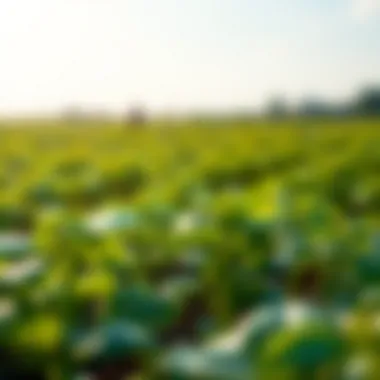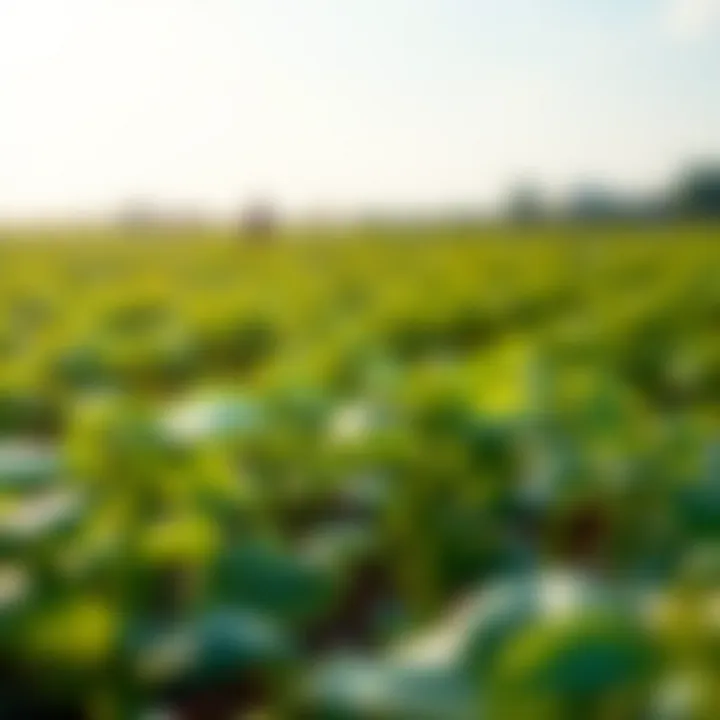Spinosad Spray for Plants: Applications and Benefits


Intro
As the world grapples with the need for sustainable practices in agriculture, the spotlight shines brightly on innovative solutions that promote plant health while protecting the environment. One such solution is spinosad spray, an effective bio-insecticide derived from the fermentation of the naturally occurring bacteria Saccharopolyspora spinosa. The increasing demand for eco-friendly agricultural practices has both farmers and enthusiasts looking to tools like spinosad to manage pests without the detrimental impacts often associated with traditional chemical pesticides.
Understanding what spinosad spray is and how it functions is essential for anyone involved in horticulture or gardening. As we embark on this exploration of spinosad, we’ll look at crucial concepts, recent trends, practical applications, and what makes it a valuable asset in sustainable practices.
By gaining insights into spinosad's applications, benefits, and safety considerations, agriculture practitioners and hobby gardeners alike can make informed decisions. We’re here to peel back the layers and pave a clear path through the thicket of information surrounding this remarkable pest control method.
Understanding Spinosad
The significance of comprehending spinosad cannot be overstated, especially in today’s environmentally-conscious world. Treating plants effectively while minimizing harm to beneficial organisms is crucial for sustainable agriculture. Spinosad serves as an effective tool for managing pest populations and enhancing plant health. Its unique characteristics distinguish it from conventional pesticides, balancing efficacy with a lower environmental footprint. By understanding spinosad’s origin, chemical makeup, and how it works, farmers and gardening enthusiasts can make informed choices regarding its application.
Origin and Discovery
Spinosad is not exactly a product of just any laboratory. It first came onto the scene thanks to the fermentation process utilizing the soil actinomycete Saccharopolyspora spinosa. Discovered in the late 1980s by scientists at the Dow AgroSciences, this naturally derived insecticide has become a formidable opponent to a variety of pests while being relatively gentle on non-target organisms. The roots of this solution lie in better understanding the ecosystem's natural protective mechanisms. This shows how nature can offer solutions to problems caused by human activities in agriculture. The pathway from discovery to widespread use is one that emphasizes the importance of seeking organic solutions in pest management, aligning with the rising demand for sustainable practices.
Chemical Composition
At its core, spinosad is a blend of spinosyn A and spinosyn D, both of which are secondary metabolites produced by the Saccharopolyspora spinosa bacterium. These two components work in tandem to disrupt the normal functioning of the nervous system in susceptible insects, making it a potent yet selective killer. The mild chemical nature of spinosad means it has a much lower toxicity to non-target species, such as pollinators and beneficial insects like ladybugs.
Its unique composition not only aids in its efficiency against pests but also underscores the growing trend of embracing biopesticides over synthetic ones. Moreover, its low solubility in water contributes to its persistence in the field, providing prolonged action against pests without the need for frequent applications.
Mechanism of Action
Understanding how spinosad operates reveals its competitive advantage in the pest management arena. Primarily, it affects the insect's nervous system—more specifically, the nicotinic acetylcholine receptors. When insects ingest or come into contact with spinosad, it leads to uncontrollable spasms and eventual death. The effectiveness of spinosad is enhanced by the fact that it can kill insects both on contact and through ingestion, making it versatile.
This dual action mechanism not only allows for quick effects on pest populations but also positions spinosad as a desirable option for those invested in maintaining plant health. Furthermore, spinosad has efficacy against a wide range of pests, including thrips, fruit flies, and leaf miners, contributing to its reputation as a reliable choice for gardeners and farmers alike.
"Spinosad’s selectivity allows practitioners to protect their crops without as much collateral damage to beneficial insects."
In summary, grasping the origin, chemical make-up, and action of spinosad gives agricultural producers and plant lovers the insight they need to effectively wield this pesticide's potential, leading to healthier plants and more sustainable practices.
Benefits of Using Spinosad Spray
When it comes to plant health and pest management, understanding the potential benefits of spinosad spray is crucial for anyone in agriculture, gardening, or horticulture. This bio-insecticide not only targets harmful pests but also maintains a balance within the ecosystem. Let’s break down the key advantages.
Effectiveness Against Insect Pests
Spinosad is quite effective in managing various insect pests. It specifically targets common culprits such as thrips, leafminers, and spider mites. Unlike some traditional pesticides that might require multiple applications, spinosad often delivers results in a single treatment.
Research has shown that the active ingredients in spinosad cause paralysis in insects, leading to their eventual demise. With this bio-insecticide, farmers can minimize pest outbreaks efficiently. Numerous studies have indicated that crops treated with spinosad yield a significant reduction in pest populations, which in turn boosts overall production.
Impact on Beneficial Insects
One of the greatest advantages of using spinosad spray is its selective toxicity. This means it effectively manages harmful insects while having minimal impact on beneficial insects like ladybugs and lacewings. In fact, some studies suggest that spinosad can actually enhance the population of these helpful allies, creating a more balanced ecosystem.
A farmer might use spinosad, observing their aphid problem greatly reduced, without noticing a decline in the ladybug population. This not only preserves the natural pest control mechanisms already in place but also fosters biodiversity, which is essential for long-term agricultural health.
"By preserving beneficial insects through targeted approaches like spinosad application, farmers can develop a sustainable system that reduces reliance on chemical interventions."
Lower Environmental Impact
Spinosad’s formulation comes with a lower environmental footprint compared to many synthetic insecticides. It is derived from naturally occurring microorganisms, making it more appealing for sustainable agriculture practices. This reduced toxicity means less risk of runoff contamination in water sources. It is biodegradable, breaking down more quickly than many conventional pesticides. This characteristic not only safeguards surrounding flora and fauna but also ensures the health of the soil.
Farmers adopting spinosad often report a decreased need for subsequent applications, further cutting down on chemical exposure in the environment. Additionally, using this bio-insecticide supports the growing trend toward organic farming, meeting consumer demand for eco-friendly produce.
Application Techniques
In applying spinosad spray effectively, knowing the right techniques is crucial. These methods not only ensure that the product works as intended but also minimize any negative impacts to the surrounding environment. Utilizing proper application techniques can significantly enhance the effectiveness of spinosad, allowing plants to better thrive while keeping unwanted pests at bay.


Dilution and Preparation
Before you even think about spraying, understanding how to dilute and prepare spinosad correctly is key. The concentration of the product can vary depending on the target pest and plants being treated. A common recommendation is to start with a dilution ratio of about 1 to 3 ounces of spinosad per gallon of water. This ratio can be adjusted based on specific guidelines from the manufacturer.
Preparing the solution properly entails mixing the spinosad well with the water. If done improperly, you run the risk of uneven application, resulting in some areas receiving too much pesticide and others too little. It’s a bit like making a good cup of coffee: the right balance is essential for the perfect brew.
- Use clean water: Always use fresh and clean water for dilution to avoid introducing any unwanted chemicals.
- Thorough mixing: Stir the solution for a few minutes to ensure a uniform product.
Spraying Methods
Once your spinosad is properly diluted, the next step is how you apply it. Spraying methods can play a vital role in how well the solution reaches the plant's surface. There are a few approaches you can consider:
- Handheld Sprayers: Ideal for small gardens or targeted applications. These allow for precision but might require more effort.
- Backpack Sprayers: These are great for medium farms. They give you the freedom to move around without being tethered to a hose.
- Motorized Sprayers: For larger fields, these sprayers cover extensive areas more quickly and efficiently. However, they require more setup and maintenance.
Regardless of the method chosen, ensure that the spinosad solution. It’s important to cover the foliage thoroughly, especially the undersides of leaves where pests often hide. This thoroughness can make the difference between a pest-infested plant and a healthy one.
Timing of Application
Timing can be everything when it comes to pesticide application. Ideally, spinosad spray should be applied during specific periods of the day when pests are most active. Early morning or late afternoon is often seen as the best time. When temperatures are cooler, the chance of harming beneficial insects is greatly reduced, and the spinosad can be more effective.
- Avoid windy days: Wind can carry the spray off-target or dilute its effectiveness.
- Watch for rain: Ideally, you want to apply spinosad a day or two before rain is expected. This platform gives the solution enough time to adhere and act on pests without being washed away.
This holistic approach can lead to more sustainable gardening practices while keeping your plants healthy and pest-free.
Safety Considerations
When utilizing any product in agriculture, especially pest management solutions like spinosad spray, it’s crucial to take safety into account. Understanding safety considerations helps ensure not only the well-being of the user but also the health of the surrounding environment and the efficacy of the treatment. In this section, we will delve into essential elements surrounding the safe use of spinosad spray, discussing handling precautions and its potential impact on human health.
Handling Precautions
Ensuring safe handling of spinosad is pivotal to minimize risks associated with its application. Here are some key points to consider:
- Personal Protective Equipment (PPE): Always don appropriate PPE, which includes gloves, goggles, and a mask to guard against direct contact and inhalation of the spray. This is an institution to prioritize safety.
- Storage Guidelines: Store spinosad in a secure, cool, and dry location away from direct sunlight and out of reach of children and pets. Following a strict storage regimen helps in preventing accidental exposure.
- Mixing and Application: When mixing the concentrate with water, do so in a well-ventilated area to reduce inhalation risks. Ensure you’re not eating or drinking at this time, as it can lead to unintended ingestion of harmful substances.
- Clean-Up Procedures: After application, wash hands and any exposed skin thoroughly. Also, clean all equipment used in the spraying process. This not only protects the user but also prevents contamination of food sources and the environment.
Following these precautions can significantly mitigate risks and enhance the safe use of spinosad spray in various settings.
Impact on Human Health
Understandably, one of the biggest concerns surrounding the use of agricultural chemicals is their impact on human health. Spinosad, derived from natural components, is often heralded as a safer alternative compared to conventional synthetic pesticides. However, a closer examination is warranted:
- Low Toxicity Levels: The toxicity levels of spinosad are lower when compared to other chemicals. According to the Environmental Protection Agency, spinosad is classified as having low toxicity to humans.
- Potential Reactions: Some individuals may experience allergic reactions or sensitivities to spinosad. Therefore, it is wise to stay alert for any unusual symptoms following exposure, particularly if using it for the first time.
- Inhalation Risks: When spraying, there is a slight risk of inhalation. Keeping distance during application can significantly lessen potential health risks.
- Environmental Considerations: Although spinosad is deemed safer than many traditional pesticides, it is still important to recognize its effects on ecosystems and aquatic life. Practicing proper application techniques helps diminish indirect health impacts that may arise from environmental contamination.
Overall, while spinosad spray is generally considered safe for humans, it is essential to follow safety procedures to ensure no adverse effects occur.
"Even clean crops deserve a little caution – it's all about balance in nature and health."
For further information regarding safe handling and health impacts of pesticides, consult the Environmental Protection Agency or National Pesticide Information Retrieval System.
Regulatory Aspects
Understanding the regulatory framework surrounding spinosad spray is crucial for its effective and safe use within agricultural practices. Regulations not only ensure the safety of this bio-insecticide for plants but also protect the health of end-users and the environment. The approval processes and labeling standards set by food and agricultural authorities reflect a commitment to sustainable farming practices. This section highlights the significance of these regulations, emphasizing their role in promoting responsible use while maximizing the benefits spinosad can offer.
Approval Process
The approval process for spinosad spray involves thorough evaluation by regulatory bodies, such as the U.S. Environmental Protection Agency (EPA) and similar entities across the globe. Initially, manufacturers submit data that details the efficacy, environmental impacts, and potential risks associated with the chemical’s use. These evaluations incorporate scientific studies that assess toxicity levels, environmental persistence, and potential effects on non-target species.
Following this, a series of trials may be required to demonstrate the safety and effectiveness of the product under various conditions. Each step in the process is vital, as it helps to ensure that the product meets rigorous safety standards before it can be marketed. Without such stringent regulations, there would be a greater risk of harmful side effects arising from improper usage or exposure.
Labeling and Usage Guidelines


Proper labeling and usage guidelines are fundamental elements that accompany spinosad products post-approval. These labels not only provide crucial information about how to safely apply the product but also outline any precautionary measures that need to be taken. For instance, labels typically indicate the concentrations at which spinosad should be diluted, the frequency of application, and specific pest types it targets.
Moreover, guidelines may also point out any environmental considerations. For instance, spinosad should not be applied near bodies of water as it can adversely affect aquatic life. This information is designed to empower users, ensuring they understand how to maximize the benefits of the spray while minimizing risk. By adhering to these guidelines, farmers and gardeners can contribute positively to pest management efforts, maintaining both plant health and ecological balance.
"The efficacy of spinosad is closely tied to its proper application, governed by rigorous labeling and safety standards envisioned by experts in the field."
In summary, regulatory aspects play a fundamental role in the application of spinosad spray. They not only streamline its introduction into the market but also equip users with the knowledge needed to utilize this product safely and effectively. Understanding these regulations enables agriculture enthusiasts to adopt sustainable practices confidently.
Comparative Analysis
The comparative analysis between spinosad and traditional pesticides provides valuable insights into their relative effectiveness, safety, and environmental impact. Understanding these differences is crucial for both agricultural professionals and enthusiasts in order to make informed decisions that align with sustainable practices. As the agricultural sector increasingly seeks alternatives that balance efficacy with safety, dissecting these methodologies unveils significant considerations for modern farming.
Spinosad vs Traditional Pesticides
Spinosad has earned its stripes as a viable alternative to conventional pesticides for various reasons. Here are some key points of comparison:
- Mechanism of Action: Spinosad operates by affecting the nervous system of insects, which leads to paralysis and ultimately, death. Traditional pesticides may employ a broader range of chemical mechanisms that can also harm beneficial insects and create resistance in target pests.
- Target Specificity: One of the most notable advantages of spinosad is its target specificity. Since it is derived from naturally occurring bacteria, it is less likely to harm non-target organisms. Traditional pesticides often lack this precision and can indiscriminately impact a wider range of species, including species beneficial to plant health.
- Residue Concerns: Farmers frequently worry about pesticide residues in crops. Spinosad is noted for its relatively quick breakdown in the environment and on plants. In contrast, many traditional synthetic pesticides can persist longer, raising more concerns with consumers regarding food safety.
- Impact on Ecosystem: Spinosad's targeted approach generally results in a lower environmental impact, thus supporting biodiversity in agroecosystems. Traditional pesticides can disrupt ecosystems, leading to declines in beneficial insect populations, and affecting pollination and other essential ecosystem services.
In summary, while traditional pesticides have long been mainstays in pest management, the use of spinosad provides a compelling alternative that combines effectiveness with a lower risk to non-target species. Farmers looking to make environmentally responsible choices might find spinosad’s benefits appealing.
Cost-Effectiveness
Cost-effectiveness is an essential consideration when evaluating pest management strategies. Here’s how spinosad fits into the economic landscape:
- Initial Cost vs Long-Term Savings: While the upfront cost of spinosad may be on par with some traditional solutions, the potential for long-term savings is noteworthy. Fewer pests lead to healthier plants and subsequently, a more robust yield, ultimately enhancing the profitability of crops.
- Reduction of Reapplications: Due to the effective performance of spinosad, many users have reported needing fewer applications compared to traditional pesticides. This can lead to substantial labor savings and reduced costs associated with repeated treatments.
- Market Demand: The increasing consumer preference for organic and environmentally friendly products can open up premium pricing opportunities for farmers using spinosad. Being able to market produce as “grown with natural insecticides” can appeal to a segment of consumers willing to pay a bit more. Thus, spinosad not only aligns with sustainability goals but could also translate into increased revenue.
- Accessibility of Resources: Often, traditional pesticides may require specialized equipment or training for application, which can be an additional financial barrier. In contrast, spinosad’s application techniques are typically more user-friendly and adaptable for a range of farming operations.
Sustainable Practices in Agriculture
Sustainable agricultural practices are essential for ensuring that farming can meet today’s needs without compromising the ability of future generations to do the same. In the context of using spinosad spray, sustainability involves considerations that align environmentally friendly methods with effective pest management. This approach is not just a trend, but a necessity in preserving our natural resources and improving biodiversity. Many growers today are looking beyond just yield; they want healthy ecosystems on their farms. As such, spinosad spray emerges as an exciting bio-insecticide that supports responsible farming and ecological balance.
Integrating sustainable methods helps reduce the reliance on conventional pesticides that often come laden with drawbacks, such as soil degradation and pest resistance. Here are some critical aspects of sustainable practices in agriculture, especially when considering spinosad:
- Environmental Integrity: By using spinosad, farmers tap into a natural compound originating from soil-dwelling bacteria. This not only mitigates chemical residues in the environment but actively works towards preserving beneficial organisms.
- Economic Viability: Sustainability isn’t merely about saving the planet; it also makes solid economic sense in the long run. By employing spinosad within Integrated Pest Management (IPM) systems, growers can limit their pesticide expenses while boosting crop health and quality. Robust plants naturally fend off pests better, creating a win-win situation.
- Public Trust: Consumers today are increasingly aware of what goes into their food. Opting for sustainable practices can boost public trust and marketability. By using products like spinosad, farmers can proudly claim their commitment to the environment and sustainability.
"Sustainable practices are not just about avoiding harm; they are about creating a healthy relationship between agriculture and nature."
Integrating Spinosad into Pest Management Programs
Incorporating spinosad into existing pest management programs embodies a thoughtful blend of science and agronomy. The substance offers a less toxic alternative compared to chemical pesticides, thus aligning well with modern IPM approaches. When integrating spinosad:
- Assessment of Pest Pressure: Prior to application, understanding the insect population is crucial. Regular monitoring can help farmers determine the most effective times for spinosad use, ensuring they target pests when they are most vulnerable.
- Combination with Other Techniques: Rather than relying solely on spinosad, it is vital to incorporate a mix of cultural, biological, and mechanical controls. This synergistic approach maximizes benefits and minimizes the risks of fostering resistance among insect populations.
- Adherence to Guidelines: Always refer to established guidelines when applying spinosad. Proper dosing, timing, and methods promote its effectiveness while safeguarding plants and beneficial insects.
Role in Organic Farming
Spinosad has carved out a significant niche within organic farming, thanks to its natural origins and low toxicity to non-target organisms. Organic farmers can utilize it to combat various pests without stepping off the path of sustainable production. Here’s why spinosad is a game-changer for organic practices:
- Natural Reduction of Chemical Inputs: Since spinosad is derived from the fermentation of Saccharopolyspora spinosa, it meets organic certification standards. This allows farmers to maintain their organic status while eradicating pest threats.
- Selective Activity: One of the attractive features of spinosad is its target-specific action. It primarily affects certain pests, leaving beneficial insects such as bees and ladybugs unharmed. This selective toxicity is paramount for organic ecosystems, ensuring that vital pollinators thrive alongside crop production.
- Compliance and Adoption: With an increased consumer preference for organic products, adopting spinosad can help farmers stand out in the marketplace. Being able to market pest-resistant and healthier crops produced with minimal impact on the environment aligns well with organic farming's inherent philosophy.
Effect on Plant Development
Understanding how spinosad spray affects plant development is crucial for its effective use in horticulture. As farmers and gardening enthusiasts look for sustainable pest management solutions, knowledge of the consequences that come with pesticide use is paramount. Spinosad, being a naturally derived insecticide, claims to strike a balance between effectiveness against pests while being gentle on plants. The main concern here revolves around phytotoxicity, which refers to the potential for a substance to be toxic to plant tissues, hindering their growth or causing harm.
Phytotoxicity Considerations
When we talk about phytotoxicity in the context of spinosad, it is essential to evaluate several factors that may influence its effects on plants.
- Application Rates: One of the most significant aspects of spinosad usage is the concentration applied. Using doses higher than recommended can lead to adverse reactions, causing leaf burn or stunted growth.
- Plant Type: Different plant species have varying tolerances to pesticides. For instance, while some ornamental plants may experience minimal effects, certain crops like tomatoes are more sensitive to phytotoxicity. Recognizing these differences is essential in preventing plant damage.
- Environmental Conditions: Factors such as humidity, temperature, and sunlight can also play a role in the phytotoxic potential of spinosad. Applying in cooler temperatures or high humidity could lessen the risk of negative effects.
Additionally, it is worth considering the timing of application during the plant's growth cycle. Young, tender plants usually exhibit greater sensitivity compared to mature plants. Thus, careful timing linked with plant development stages can mitigate undesirable outcomes.


Upon reading feedback and experiences shared by farmers, a common theme emerges: many report no significant phytotoxic effects when spinosad is used correctly. In some instances, they note an increase in overall plant vigor post-application, possibly due to reduced pest populations that would have otherwise hindered the plants.
"The key is understanding and respecting the limits of what spinosad can do for your plants. Always observe and adjust your methods to ensure your plants thrive alongside pest management efforts."
It's crucial for users to conduct a patch test when using spinosad sprays for the first time on new or sensitive plant varieties. This can help determine how a specific plant reacts to the application and provides the opportunity for adjustments before full-scale use.
In summary, while spinosad presents numerous benefits for pest control in agriculture, paying attention to phytotoxicity is key. Knowing how to apply, when to apply, and on what types of plants is necessary to ensure a healthy balance between effective pest management and robust plant development.
Case Studies and Practical Applications
Understanding the real-world impact of spinosad spray in agricultural settings sheds light on its practical benefits and nuances in implementation. Case studies provide tangible evidence of performance in the field, showcasing how this bio-insecticide not only aids in pest control but also aligns with sustainable practices that many modern farmers are striving for. Analyzing these real-life situations helps elucidate the strengths and potential limitations of spinosad, as seen through the eyes of those who wield it in their daily routines.
The exploration of practical applications illustrates a crucial intersection between science and practice. Farmers who have adopted spinosad in their pest management strategies bring firsthand experiences that can guide others in the community. These stories of success serve to inspire confidence in transitioning to this bio-based approach, while also addressing any skepticism that might linger in the minds of traditionalists.
Success Stories from Farmers
Several farmers across different regions have begun incorporating spinosad into their pest management practices with notable outcomes. These anecdotes serve not just as testimonials, but as valuable learning experiences for others in the agricultural sector.
One striking example comes from a small organic farm in California that specializes in growing strawberries. Facing a persistent threat from thrips, the farmer decided to switch to spinosad spray after finding conventional pesticides posed risks to beneficial insect populations and the surrounding ecosystem. After weeks of monitoring, the results were clear: a significant decline in pest numbers with no reported harm to beneficial insects such as ladybugs. The farmer noted, "Switching to spinosad not only rescued my crops but also brought back the beneficials I thought I’d lost forever."
Another inspiring case is that of a greenhouse operator in the Midwest, dealing with aphid infestations in tomato plants. The operator combined spinosad with integrated pest management practices, utilizing traps and natural predators like lacewing larvae. This cooperative approach paved the way for a healthy harvest without the chemical residues often associated with synthetic pesticides.
Farmers have remarked on the ease of application with spinosad, often preferring it over more tedious chemical options. The versatility in application methods—be it spray, drench, or even dusting—offers convenience that can fit into various operational scales. According to one farmer in Florida, "The flexibility of how I can use spinosad lets me adapt to the specific needs of my crops and the challenge of the season."
Success stories like these not only highlight the efficacy of spinosad but also reflect a shift towards more responsible farming practices.
Key Takeaways
- Farmers report effective pest management without compromising beneficial insect populations.
- Success stories reveal adaptability of spinosad in diverse agricultural settings, making it a viable choice for many farmers.
- The use of spinosad is coupled with integrated pest management, enhancing overall sustainability.
Through these narratives, it becomes plain that spinosad is more than just a spray; it represents a progressive step in how pest management can be conducted in a way that honors both crop health and environmental integrity. As these stories circulate among agricultural circles, they serve as a glowing beacon for both existing and future practitioners looking to embrace innovation in farming.
Future Directions in Research
Exploring the future directions in research surrounding spinosad spray reveals the critical trajectory for enhancing agricultural practices. As the global demand for sustainable farming rises, ongoing studies are essential for maximizing the potential of spinosad and refining its applications. Future research initiatives will likely zero in on several focal points:
- Enhanced Formulations: Investigating new formulations that could improve the efficiency and longevity of spinosad’s effectiveness against a wider range of pests. This might include using nano-encapsulation techniques or adding synergistic ingredients that boost its pest control capabilities.
- Resistance Management: With increasing concerns about insect resistance, studies will delve into developing strategies to mitigate resistance. This research is vital to ensure that spinosad remains a viable option for pest management in the long term, maintaining its efficacy across various crops.
- Integrated Pest Management (IPM): The role of spinosad in IPM systems will require further exploration. Research could provide insights into how spinosad can be used complementary to other biological and mechanical pest management strategies.
- Environmental impact assessments: Reevaluating the environmental impact of spinosad, particularly on non-target organisms, will be crucial. Future studies may focus on long-term ecological effects, improving the understanding of its interaction within the ecosystem.
- Market Access and Farmer Education: Future research can also dive into how the agricultural community perceives spinosad and its alternatives. Effective outreach and education are keys to ensuring farmers make informed decisions regarding pest management. Possible training programs could enhance understanding of spinosad’s benefits and safe application.
"Innovations in research are crucial for keeping agricultural practices up to speed with the changing demands of sustainability and pest control."
In summary, focusing on these directions could further reinforce the place of spinosad within sustainable agricultural practices. The collective efforts in these areas will not only enhance spinosad’s profile as a bio-insecticide but also contribute to a broader understanding of sustainable agricultural methodologies.
Innovations in Bio-Insecticides
The realm of bio-insecticides continues to evolve, presenting exciting opportunities. Current innovations are paving the way for future breakthroughs in pest management. Here are a few interesting avenues researchers are exploring:
- Microbial Biopesticides: Leveraging the natural enemies of pest species, this area focuses on introducing beneficial microorganisms into agricultural systems. These biopesticides can work synergistically with spinosad, targeting pests more precisely.
- Plant-Incorporated Protectants: Genetic engineering might enable crops to produce their own spinosad-like compounds, potentially reducing reliance on external applications and improving pest resistance.
- Digital Pest Management Tools: The integration of technology, such as drones and IoT sensors, could revolutionize monitoring pests and applying spinosad in a targeted manner. This minimizes input costs and optimizes treatments according to pest life cycles.
- Next-Generation Spraying Methods: Innovations are developing in agricultural spray equipment that could ensure better coverage and less drift, enhancing the efficiency of spinosad applications.
Alongside these innovative strides, it becomes increasingly essential to conduct thorough assessments of the efficacy and safety of emerging bio-insecticides. The balance of effective pest control with environmental safety will be critical as farmers adapt to new technologies and methods.
Future research into spinosad and its synergistic developments could lead to exciting advancements, making sustainable agriculture more efficient and manageable. Adapting to these evolutionary changes in pest management would provide a cutting-edge approach to conquering agricultural challenges.
Closure
In an era where sustainable practices are crucial for the future of agriculture, the usage of spinosad spray stands out as an innovative solution that aligns with modern ecological needs. The article has taken a thorough look at the diverse applications and benefits of spinosad, shedding light on its role not just as a pest control measure, but as a holistic approach to gardening and farming.
Summary of Benefits and Considerations
To summarize, spinosad offers several advantages that are particularly relevant for today's agriculture enthusiasts.
- Effectiveness: Spinosad is proven to effectively target a range of insect pests without causing significant harm to beneficial organisms. This selective action means that gardeners can protect their crops while maintaining a healthy ecosystem around them.
- Environmental Safety: Unlike many conventional pesticides, spinosad breaks down more rapidly in the environment, reducing the risk of accumulation in soil or water. This characteristic underscores its suitability for organic farming and sustainable gardening practices.
- Ease of Use: The application methods are straightforward, allowing both novice and seasoned gardeners to integrate spinosad into their pest management strategies without much hassle.
However, certain considerations must be kept in mind. While spinosad is efficient, its effectiveness can sometimes be influenced by factors like application timing and concentration. Moreover, it is essential to consistently monitor its impact on the target pests, adapting strategies based on observed results.
Final Thoughts on Spinosad Usage
Using spinosad can be a game-changer in plant management for many. For those who are dedicated to making eco-friendly choices in their gardening practices, it presents a potent tool that aligns well with sustainable methodologies. However, as with any pesticide, the key lies in educated application. Understanding the biochemistry behind how spinosad works could help users maximize its benefits while minimizing any unintended consequences.















